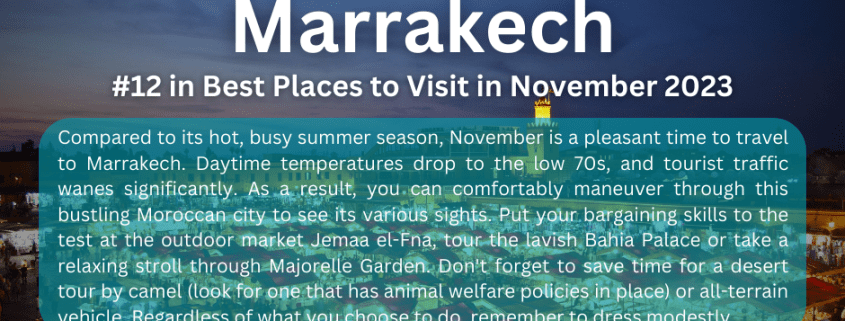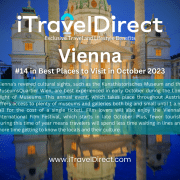Marrakech #12 in Best Places to Visit in November 2023
Why Go To Marrakech
For the organized, logical traveler, Marrakech may seem like a nightmare. Its labyrinth of twisty alleyways are almost impossible to navigate, not that its array of snake charmers, fortune tellers and spice sellers will let you go anywhere fast. The problem here isn’t the city: It’s your state-of-mind. Leave your structured daily routine behind and let the ebb and flow of Marrakech draw you deeper into its colorful chaos.
Start your visit within the salmon-pink walls of the Medina of Marrakech, which contrasts with the white, jagged peaks of the nearby Atlas Mountains and serves as the inspiration for the city’s nickname, the Red City. This ancient part of Marrakech houses the famous Jemaa El Fna square that brims with food vendors selling everything from sheep’s heads to snails beneath creamy awnings. From here, allow yourself to be lured down the shadowy alleyways to souks (or markets) filled with cones of burgundy-, auburn- and citrine-hued spices exuding an aromatic haze. Stroll past the carpet sellers, with their cobalt-, jade-, and crimson-threaded merchandise, and make your way to architectural marvels like Koutoubia Mosque and the Bahia Palace. Should you desire a break from the medina’s bustling streets, retreat to a hammam (public bath) or Majorelle Garden.
Best Months to Visit
The best times to visit Marrakech are from March to May and between September and November. These shoulder seasons are known for their desirable weather (with average daytime temps in the low 70s to low 90s) and affordable hotel rates. Avoid visiting in the brutally hot summer when highs regularly top 100 degrees and the city sees a large influx of tourists and expats. The winter months offer temperatures in the low 40s to upper 60s but also see a spike in tourism, with visitors from colder climates flocking to the Red City in search of warmer temps. Be mindful of religious holidays, such as Ramadan and Christmas, as well as national holidays that follow the lunar calendar, which can affect everything from public transportation to attraction hours to room rates.
Culture & Customs
Imagine holding the past in one hand, the present in the other and mashing them together – Marrakech would be the result. The ancient ramparts seem to keep time from escaping the medina and its bustling Jemaa El Fna, which is filled with lively Berber chemists, snake charmers and more. Meanwhile, in Ville Nouvelle (New Town), located just outside the medina walls, you’ll discover a city reminiscent of quintessential France. Wide boulevards contrast the old city’s narrow alleyways, while chic cafes take the place of crowded spice stalls.
Marrakech’s dueling influences – French and North African – have created a hybrid of cultural traditions. While you’ll most likely hear locals speaking Darija (Moroccan Arabic), residents will often greet you with a hearty “bonjour” (hello). Many residents know limited English as well, but carrying around a French phrasebook and learning a few key phrases in Darija and French – such as “Labas?” and “Comment allez-vous?” (How are you?), “Ma’arft” and “Je ne comprend pas” (I don’t understand), and “shukran” and “merci” (thank you) – won’t hurt.
Christians and Jews make up a fair portion of Marrakech’s population, but Islam is the dominant religion here. The city is speckled with dramatic domed mosques, including Koutoubia Mosque in the medina. Visitors can admire the ornate arches from the outside, but the interiors are reserved for practicing Muslims. Although strict dress codes aren’t enforced, wearing conservative attire (think: shirts and pants that cover your shoulders, chest, midriff and knees) is strongly advised, especially in older parts of the city.
The Moroccan dirham is Morocco’s official currency. One dirham is equal to $0.11. Euros (1 euro equals approximately $1.22) are also accepted by some vendors in Marrakech, but exchange rates are generally more favorable when using dirhams. Most shopkeepers and restaurants do not accept credit cards. Dirham to dollar rates often fluctuate, so check the latest exchange rate before you go.
There is no standard tipping policy in Morocco, but it is generally best to leave at least 10 percent of your restaurant bill when you receive great service. Some eateries in areas frequented by tourists will automatically add a tip to your bill, so be sure to check before tipping. For taxi services, round up to the nearest 5 dirhams. When visiting a hammam, it’s customary to leave 20 to 25 dirhams (or $2 to $3) per attendant. And at hotels, expect to give 10 to 20 dirhams ($1 to $2) to bellhops and 20 dirhams (about $2) per day or 100 dirhams (less than $11) per week to housekeepers. Professional tour guides are paid well, so tipping for their services is not expected.
What to Eat
One of North Africa’s most unique cuisines is Moroccan, and one of the best places to sample it is in Marrakech. Known for their unconventional flavor combinations and subtle spices (think: cinnamon, saffron, cumin and turmeric), Moroccan dishes are featured on many restaurant and cooking class menus throughout Marrakech. Must-try delicacies include tagines (stews baked in traditional clay, cone-shaped pots that go by the same name), couscous (a fine wheat pasta commonly served with a protein and vegetables) and salads made with ingredients like carrots and dates. Traveler-approved restaurants that specialize in authentic Moroccan fare include Corner Cafe, Dar Chef and Libzar.
No visit to Marrakech would be complete without savoring the city’s world-renowned street fare. Areas like Jemaa El Fna are packed with food stalls selling an array of tasty items. Traditional options include b’stilla (a layered pastry made with pigeon, almonds, eggs and various spices), harira (a tomato-, chickpea- and lentil-based soup generally served during Ramadan) and snails simmered in a citrusy, herb-filled broth. Another delicacy prepared by some street vendors is steamed sheep’s head, which is sold by the half or whole head. For less adventurous travelers, Marrakech also offers kabobs (grilled, skewered meats), makouda (deep-fried potato balls) and chebakia (fried sesame cookies molded into flower shapes).
To cool off after a long day in the sun, Moroccans love to sip orange juice, which is made with oranges grown in Marrakech’s alleys and courtyards. Additionally, locals enjoy serving mint tea to guests or drinking it while catching up with friends. This flavorful tea combines gunpowder tea (a kind of Chinese green tea), sugar and fresh spearmint leaves, and is poured from high above the glass to create a crown (or froth). Both beverages are available at food stalls and restaurants throughout the city.
Getting Around Marrakech
The best way to get around Marrakech is on foot. Sure, this is a big city, but most of the main attractions are clustered at or within walking distance of the medina. Alternatively, if you’re looking for a fun way to get from the medina to other parts of the city, consider taking a calèche (horse-drawn carriage). Or, you can take one of ALSA’s Tourist Buses to many popular Marrakech sights. Upon flying into Casablanca’s Mohammed V International Airport (CMN) and taking a train to the Marrakech Train Station or continuing on to Marrakech Menara Airport (RAK), located about 5 miles southwest of the medina, you can either take a taxi or an ALSA bus to the city center. Many hotels also offer airport shuttle services.
On Foot
Getting around Marrakech on foot is relatively easy. Most of the Red City’s must-see sights can be found inside the walls of the medina. However, you may want to consider hiring a professional guide, as the medina’s winding alleyways can be tricky to navigate. While you’ll find many locals in Jemaa El Fna offering to show you around, these individuals tend to charge high fees, so opt for a more reputable guide through your hotel or from a local tour company. If you decide to venture out on your own, make sure to carry a comprehensive map or guidebook. Many of the street signs are in Arabic, and you could find yourself wandering aimlessly for hours (though that may not be a bad thing).
Bus
Public bus services are available through ALSA Marrakech, but there is no set schedule, and routes – which are available on ALSA’s Urban Itineraries page – can be confusing. If you decide to use this mode of transportation, expect most buses to operate daily every 10 to 60 minutes, depending on the line. One-way tickets cost 3 or 4 Moroccan dirhams (or less than 50 cents) for adults and kids 6 and older.
A more convenient way to get around Marrakech is to use ALSA’s Tourist Bus system. This two-line network is designed with visitors in mind: The History Tour and Oasis Tour Tourist Buses can get you to and from the airport, and they’ll also carry you to Marrakech’s primary attractions, including Kouboubia Mosque, Majorelle Garden and the Saadian Tombs. You can purchase Tourist Bus tickets valid for 24 or 48 hours for 145 to 165 dirhams (or $15 to $18) per adult and 75 to 95 dirhams (about $8 to $10) for each child ages 6 to 14; children 5 and younger ride for free. Tourist Bus schedules vary by season, but both lines are generally available between 9 a.m. and 6 p.m. every day. A map of Tourist Bus’ routes can be found on ALSA’s Tourist Bus Itineraries page.
Calèche
You’ll spot these green horse-drawn carriages everywhere in the city, but you’re more likely to find an available one at Jemaa El Fna or outside Koutoubia Mosque. Not only are calèches fun to ride in, but they can also fit more people (up to six at a time) and generally cost less than taxis. Some routes have fixed prices, but use your haggling skills and agree on a price beforehand. Expect to pay about 120 to 180 dirhams (approximately $13 to $20) for each hour-long ride. Also, avoid calèches that don’t display a SPANA badge of honor, which the British animal rights group of the same name awards to drivers who properly care for their horses.
Taxi
Ride-hailing services, such as Uber and Lyft, are not available in Marrakech, but travelers have access to two types of taxis: petits taxis and grands taxis. Petits taxis are fairly small and calculate your fare using a meter (most of the time). Grands taxis are larger and generally have a fixed rate per route. Note that standard rates do not apply to taxis operating to and from the airport, so negotiate a fee with the driver before getting in. The trip from the airport to central Marrakech takes about 15 minutes and shouldn’t cost more than 70 dirhams (roughly $7.50), though rates can be as high as 150 dirhams (about $16) at night. You’ll also want to settle on a rate before the start of your ride in petits taxis without meters.
Make sure your driver knows exactly where you’re going to avoid spending more than you anticipate. Some drivers will deliberately take you to the wrong hotel because they receive a commission from that property. Others will simply misunderstand you. To avoid confusion, clearly write down the name and address of your destination on a piece of paper.
Entry & Exit Requirements
You will need a valid passport with at least one blank page to enter Morocco, and you can stay up to 90 days without a visa. While in Marrakech, carry a photocopy of your passport (leave the physical copy in a secure location) in case local officials stop you to check your ID. To learn more about entry and exit requirements, visit the U.S. State Department’s website.
Start Saving with iTravelDirect’s Exclusive Travel and Lifestyle Benefits Membership
CLICK HERE to Test-Drive our Guaranteed Savings
We offer a 110% Price Guarantee – Find a lower price anywhere online and we will refund you 110% of the difference.
CLICK HERE for a full list of services and Membership Discounts.
When you join iTravelDirect, you’ll have full access to all club benefits.
Your membership gives you the freedom to travel when you want, to where you want.
And you won’t find lower rates anywhere, guaranteed. So, pack your bags and start planning that vacation of a lifetime today!












Leave a Reply
Want to join the discussion?Feel free to contribute!